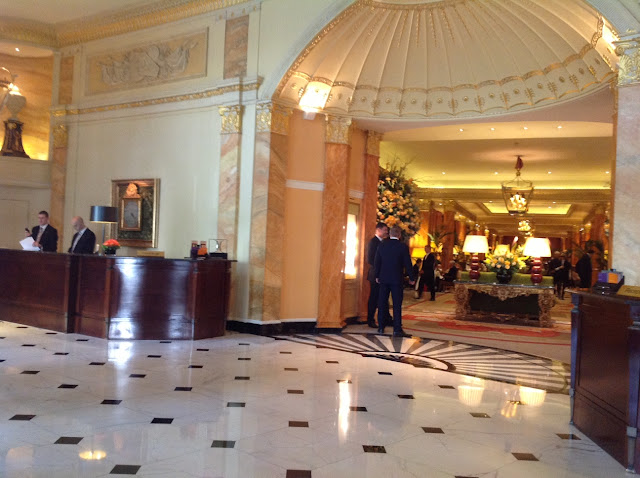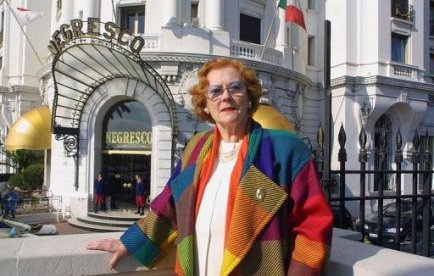THE DORCHESTER, London
 |
| A taste of luxury, Park Suite at the Dorchester |
I renewed a long-distance acquaintanceship last year with
Christopher Cowdray after writing of him
in this blog ("A Momentous Long-Distance Phone Call"). We have exchanged letters, communicated on the telephone, and chatted via email, but never actually come face to face.
In the intervening years since the episode recounted in that musing, Cowdray has gone from managing director of Claridge's to becoming CEO of the Dorchester Collection. He is in essence now at the helm of a veritable empire of international grand hotels. And not just any old grand hotel.
The Collection includes the absolute crème de la crème of international properties from Paris to Milan to Beverly Hills, not to mention England.
A congruence of circumstances resulted in an invitation last month to spend a few days at The Dorchester, the Collection's namesake and prize London property.
In the intervening years since the episode recounted in that musing, Cowdray has gone from managing director of Claridge's to becoming CEO of the Dorchester Collection. He is in essence now at the helm of a veritable empire of international grand hotels. And not just any old grand hotel.
The Collection includes the absolute crème de la crème of international properties from Paris to Milan to Beverly Hills, not to mention England.
 |
| The Promenade lobby, a London landmark |
A congruence of circumstances resulted in an invitation last month to spend a few days at The Dorchester, the Collection's namesake and prize London property.
 |
| Mendez circa 1968 (Google) |
The other time was to pick up a press release from a Middle Eastern political lobbyist. I recall his suite being of great luxury, but somehow never connected it with anything that actually touched me or the real world. I accepted his champagne and petits fours, but the political implications were entirely over my head, and I never wrote about it.
I was aware that Elizabeth Taylor and Richard Burton were living at the “Dorch” that year, but again, there was their world, and then there was the real world.
Opened in 1931, ultra modern at the time, the birth of the Dorchester oddly coincided
with that of the Great Depression which had taken a couple of years before arriving in full
force in the United Kingdom.
Because of its reinforced concrete foundation,
uncommon for its
time, it was considered one of the safest large buildings --certainly the safest hotel-- in London during the War. General Eisenhower, who had first stayed at
the Savoy, later moved and took up residence at the Dorchester.
In the last few years, The Dorchester has been discreetly reinventing itself. It has undergone
extensive renovations, rooms have been
redone and redecorated, and most suites have been completely re-thought and
transformed. It stands proudly today at
the top of its form. Because of its reinforced concrete foundation,
 |
| Ike 1944 (Historiweb) |
As we set off to catch the Eurostar for the 2 1/2 hour train journey to London, Brenda had her heart set on a view of Hyde Park. I warned her that this was unlikely, as only the most expensive rooms seemed to be on the Park side. We had been just slightly let down last year by our digs at the Savoy, and we promised ourselves not to be disappointed if the accommodations were on the small side.
They were not.
 |
| The lovely Katarina |
Imagine our enchantment when the glamorous Katarina, a "guest liaison manager", threw open the doors of the Park Suite for us. One of the hotel's most elegant apartments, I would have almost settled for just its foyer with its handsome black and white marble floor and distinctive Japanese-style wallpaper.
 |
| The stunning foyer of our suite |
Entirely redone last year, Katarina confided it was her favorite suite. I was thoroughly conquered when she said that all my questions reminded her of herself, as she, too, shared a longstanding passion for hotels.
A native of Slovakia, she first worked in London at the smaller, elitist Connaught Hotel, before moving to The Dorchester. She undoubtedly has discovered a very special world in the once-closed milieu of English palaces.
And as for the panorama, Brenda need not have worried. Even the toilet (there were two!) had a fine view of Park Lane and Hyde Park.
Our rooms, like much of the hotel, have maintained a strong feeling of the English traditional, subtly revisited by a touch of pan-Asian decor and more than a little art-déco. The Dorch has somehow found the secret to being old-fashioned and modern at the same time.
The last morning, I awakened at daybreak to just a hint of sunlight peeking through the curtains, and I savored the beauty of the bedroom's exquisite silver and gray damask wallpaper. A detail among so many.
Preparing to leave, I felt a sudden sadness. Would this be my swan song to Gatsbyesque living? I do hope not. But if so, I couldn't have found a better finale. How could I ever top it?
 |
| Brenda getting used to the luxurious bed linen and all those wonderful down-filled pillows |
Your input is welcomed: hotel-musings@hotmail.fr
Next Friday: "The Paris Riots of 1968 at l'Hotel de Lille"
[Photos are mine, unless otherwise credited]
CROSS REFERENCING … a look at other postings
Christopher Cowdray was also featured in blog No. 16, "A Momentous Long-Distance Call" Dec. 12, 2012 (to access, click on above title).








































